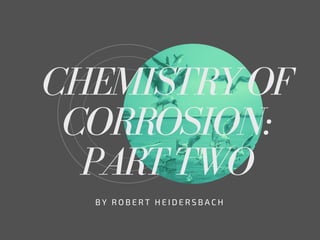
Chemistry of Corrosion Part Two by Robert Heidersbach
- 1. CHEMISTRYOF CORROSION: PARTTWO B Y R O B E R T H E I D E R S B A C H
- 3. At low electrode current densities, the change in potential can be plotted. These plots of potential versus logarithm current are often termed Evans diagrams, after Professor U.R> Evans of Cambridge University, who popularized their use. As stated above, most oilfield corrosion rates are controlled by the low concentrations of reducible species in the environment. These specify must migrate, or diffuse, to the metal surface in order to react. The rate of this diffusion is controlled by the concentration of the diffusing species in the environment, the thickness of the boundary layer where this diffusion is occurring (largely determined by fluid flow or the lack thereof), temperature, and other considerations. The resulting concentration polarization can be written as: ELECTRODE POTENTIALS AND CURRENT
- 5. The other terms are the same as described as above in discussions in the Nernst equation and activation polarization (Tafel slope) behavior. In corrosion, the limited concentrations of reducible species produce concentration polarization only at cathodes. At low current densities, the concentration polarisation is negligible, and, as the reduction current density approaches the limiting current, the slope quickly becomes a vertical downward line. ELECTRODE POTENTIALS AND CURRENT
- 6. ELECTRODE POTENTIALS AND CURRENT The total polarization of an electrode is the sum of both the activation and concentration polarization. The combined polarization for a reduction reaction on a cathode is: As stated earlier, most oilfield corrosion rates are determined by the concentration of the reducible chemicals in the environment. For surface equipment, most corrosion rates are determined by the concentration of dissolved oxygen in whatever water is available.
- 7. The importance of potential in determining corrosion rates is apparent from the above discussions. Academic chemistry reports tend to describe potentials relative to the standard hydrogen electrode, which had been arbitrarily set to a potential of zero. In field applications, it is common to use other reference electrodes. The most common reference electrodes used in oilfield work are the saturated copper-copper sulfate electrode (CSE), used in onshore applications, and the silver-silver chloride electrode used for offshore measurements, where contamination of the CSE electrode would produce variable readings. ELECTRODE POTENTIALS AND CURRENT
- 8. Marcel Pourbaix developed a means of explaining the thermodynamics of corrosion systems by plotting regions of thermodynamic sustainability of metals and their reaction plots on potential versus pH plots. The regions of a Pourbaix diagram can be described as: Immunity: The metal cannot oxidize or corrode (although it may still be subject to hydrogen embrittlement) Corrosion: Ions of the metal are thermodynamically stable and the metal will corrode. Passivity: Compounds of the metal and chemicals from the environment are thermodynamically stable, and the metal may be protected from corrosion if the passive film is adherent and protective. POTENTIAL-PH (POURBAIX) DIAGRAMS
- 9. Many users of Pourbaix diagrams miss the final point above. Thermodynamics alone cannot predict if passive films will be protective or not. There are a number of important points useful for oilfield corrosion control: POTENTIAL-PH (POURBAIX) DIAGRAMS Water is only stable over a potential range of slightly more than one volt. This is very important in cathodic protection. Iron (carbon steel) is covered with iron oxides (passive films) in most aqueous environments. Unfortunately, these passive films are not protective and other means of corrosion are necessary. The potentials at which iron (carbon steel) is protected from corrosion do not coincide with the immunity regions on the Pourbaix diagram.
- 10. The diagrams for zinc, aluminum, and cadmium, commonly referred to as the amphoteric coating metals, have passive regions in neutral environments These metals also have low corrosion rates in neutral environments and higher corrosion rates in both acids and bases. Pourbaix diagrams have limitations in addition to the inability of thermodynamics to predict the protectiveness of passive films. These include the idea that they can only be calculated for alloys, although experimental Pourbaix diagrams have been reported, POTENTIAL-PH (POURBAIX) DIAGRAMS
- 11. The following ideas have been discussed in detail this chapter: Electrode potentials are determined by: Corrosion is electrochemical in nature Most metal surfaces have both oxidation and reduction occurring simultaneously If the predominant reaction is oxidation, the metal will corrode The most important reduction reaction is in oxygen reduction for many oilfield systems. If no oxygen is available, the corrosion rate will often be very low. Meta chemistry chemicals in the environment Temperature SUMMARY
- 12. These potentials are usually measured against either copper-copper sulfate or silver-silver chloride electrodes, depending on the environment. Corrosion rates are often expressed by the average depth of penetration, and this can be misleading because most oilfield corrosion is localized in nature. The pH of the environment has a major effect on corrosivity. Passive films may limit corrosion in many environments, but carbon steel, the most common oilfield metal, seldom forms adequately protective passive films, and other means of corrosion are often necessary. SUMMARY
- 13. Checkoutthepreviewofmybook, "MetallurgyandCorrosionControlin OilandGasProduction"onGoogle Booksnow! B Y R O B E R T H E I D E R S B A C H
